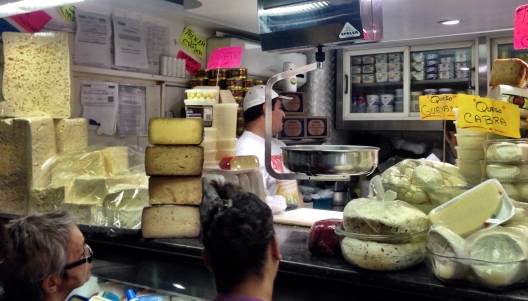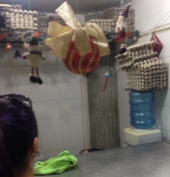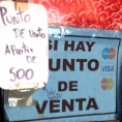One of the most fun things I do when I come to Caracas is to visit the Mercado Libre de Chacao on Sunday mornings. I just love watching the people, looking at the produce and, of course, buying those cheeses that you can only get in Venezuela. (Even if some failry good imitations are now sold abroad)
The market has changed, not only because it moved next door to a more modern building while Leopoldo Lopez was Mayor in 2008, but also because its nature has changed. What originally was created in the 40’s to have farmers from the surrounding areas bring fresh produce to sell directly, has now become a place to find what you can not find elsewhere. At premium prices, of course. But it does retain some of the original flavor, as produce remains its strength and since most produce is not regulated you can still find lots of good stuff there. (By the way, the webpage of the market ignores its previous history, only talking of the market from 2006 on, which is truly a pity)
The market has changed so much, that twenty years ago, I would go Sunday mornings because it was mostly empty (It opens from Thursdays to Sunday), but you would not necessarily find everything, most of the stuff had been sold. Today, Sunday are as bustling as any other day and what you can not get is likely due to its scarcity. The market has become so popular to look for scarce items, that even at noon on Sunday its still full.
These are some images from this morning:
On the left a picture of the produce section taken from above, you can see there is lots of produce and lots of traffic. On the right you can see the variety of produce you can find, since few of these are regulated, then you can find plenty of it at the right price. Not cheap, but most of it fresher and of better quality that you can get at the supermarket.
And then there is my favorite, the cheese vendors:

Some cheeses are regulated but many are not. He is well stocked. Note the beautiful PalmiZulia chunks on the left, the crinejas (strung cheese of a mozzarella-like cheese) on the right. One sign of the times is the “potes” (containers) of queso de mano, sort of in the middle. When these first appeared about fifteen years ago, they carried ten or twelve small “arepa size” cheeses. You can see on the left how they make them on small containers of three or four cheeses. The reason? The large container is 1200 Bs, (US$ 1.33) which most people can not afford, the smaller one is “only” Bs. 550 (US$ 0.60)
Even in the free market, it is really hard to find eggs:
On the left, you can see the empty egg store. I was told had some in the morning and they “think” they would get more in an hour. On that news, people start lining up as seeing on the picture on the rights. It’s only a hope, but the owners swears “some” will arrive.
While I was there there, was a big commotion:
The guy with the red shirt on the left is pushing a cart which has rice and oil, thus people start following him into the store on the right, where there were people already lining up for the goods that are arriving. As you can see in the picture on the right, this store specializes in hard to get goods at very high prices. You can see Corn Flakes, Domino sugar and on the left, all sorts of paper products that are scarce, such as diapers, feminine products and the like. Add oil and rice now, but those will not last long. As this was happening, the guy that owns the store where I was buying Saltine Crackers (hard to find) said to me: “I wonder where they can get that oil, I can’t”. (And that is his business line!)
The next two surprised me:
On the left a fruit stand that is usually well stocked. Most fruit stands looked sort of like this, half empty. This is not generally the case, fruit is like produce that you can find it because it is not regulated. On the right is the fish stand which was very well stocked, if you try to see the prices above the stand you will understand why, At Bs. 3,700. (US$ 4.1) it is not very affordable to the average population. (Remember the minimum monthly salary at the parallel rate of exchange is about US$ 10.7 per month)
You can have fun at the free market just reading the signs:
On the left, this stand advertises that it has a debit/credit card access point, but only for purchases above Bs. 500 (All of US$ 40 cents). In the middle a sign in the avocado stand plays a pun on the fact that the word in Spanish to play an instrument or touch something is the same: Do not touch (play), it is not a piano. BTW, the avocados were large and beautiful. Finally, a sign that says: For products with “just” prices (Maduro’s creation) there are no bags, additional bag Bs. 20 ( 2 cents).
Definitely signs of the times…
Finally, the free market continues to be a place for those with initiative:
On the left, a guy who claims to be a medical doctor and sets up a plastic table and provides Medical Certificates for driving. (Required in Venezuela) Today he was advertising hard, telling people that they should take advantage of it now, as the Government is about to increase the Tax Unit (Unidad Tributaria) which will increase the price of the Certificate, which today is at Bs. 600 (66 cents in US$). People were lining up for the bargain, including yours truly. That comes up to be about 11 US$ cents for year of validity of the certificate. (Remember on election day I was stopped by the cops and had all my documents in order, except that one)
And on the picture on the right above, the beautiful flowers grown in Galipan, inside the Avila mountain at near 6,000 feet above sea level. Flower growers from Galipan have been providing these since I was a little kid (Yes, eons ago) and as you can see, they continue to do so.
Always a welcome sight at the Mercado Libre de Chacao in Caracas.














January 28, 2016 at 9:55 pm
When government gets involved this awesome site could become a ghost town.
January 26, 2016 at 10:46 pm
And the idiots responsible for this mess think that pumping more oil…in an era of over-supply…is going to fix the problems.
At the same time they’re begging OPEC to cut down on production.
And at the same time that everyone remembers that they’ve stolen, cheated, lied and extorted from foreign oil investment partners for 1 and 3/4 decades–and now PDVSA has the fucking balls to actually expect investment?
https://www.bloomberg.com/news/articles/2016-01-26/venezuela-oil-group-seeks-incentives-to-lure-more-foreign-money
It’s fucking, fucking, fucking UNBELIEVABLE!!!
January 27, 2016 at 10:57 am
Ira, for those of us that live here every day is unbelievable.
January 26, 2016 at 9:21 pm
Los villones
January 25, 2016 at 12:07 pm
A market with hard to find products at very high (in Bs) prices. So what segment of the population shops there? Cash trumps everything else so may one visualize well-heeled reds and anti-reds picking through the tomatoes elbow to elbow? This Gringo has family and friends in Caracas and throughout the country that can’t afford the prices listed above, of course they can’t find what they need either.
January 25, 2016 at 8:00 am
Besides an eye test (I assume), does the guy actually give you some sort of medical exam?
January 25, 2016 at 8:03 am
Not really…
January 24, 2016 at 4:42 pm
What’s the next step now that the opp has said no to Maduro’s emergency decree request?
What can the Assembly now do to enact concrete economic reform, overriding the presidency?
Or should I say “idiocy?”
January 24, 2016 at 8:20 pm
Tye Asembly cant do that much except on the budget. My guess is that they will try to change the Constitution so that the term will be four years and only one reelection, which wpuld mean elections in October.
January 24, 2016 at 3:20 pm
Nice reality-check at street level.. It’s amazing how “precio justo” and “precio injusto”.. can co-exist, makes zero sense when talking about produce or anything, but anyway. It’s surreal.
Also, if there’s such a huge crisis, huge lines everywhere, and people only make 10$/month, well I need a brand new calculator from a parallel universe. Are exiled Venezuelan sending them fresh dollars, Cuban or Mexican style?
Also, fish and fruit and legumes should be abundant in times of crisis, no? If factory salaries and urban work pays so little (20$/month with a couple tigritos?), you would think people would be working hard on the country side, loading their peñeros with fish, or at least growing lots of tomatoes, aji, pimiento, patilla, mani, lechosa, and even raising a few porcs, lots of gallinas, and rabbits or turkeys. Nope.
They must have other sources of income, if all they can still produce is great cheese. I understand that you cannot produce coffee, for instance, and compete, because you get hammered by regulations, Guardia “mordidas” and unfair “precios justos” for coffee from Nicaragua.. I happen to know the largest producers of chickens and turkeys still left in Vzla. Honest families, having a very tough time trying to remain honest, they have to bribe everyone just to get the products out.
But Limon, Piña, Eggs, Fish? It just doesn’t make any sense. How do they even survive, unless, of course, some sort of Enchufe or arreglito por la esquina..
January 25, 2016 at 9:45 am
The lines are to buy regulated products at regulated prices. There is hunger in Venezuela.
January 24, 2016 at 1:40 pm
Miguel, hablando de queso, es mayor el producto del queso venezolano en Suiza que el producto del queso suizo en Venezuela. 😉
January 24, 2016 at 1:37 pm
Boutique “ELMER” (EL MERcado de Chacao) is growing more expensive by the week and I’m going back to Guaicaipuro more often now. The veggies are just as nice and cheaper but many higher priced items like olive oil are missing. Guaicaipuro has the better grain dealer while Boutique Elmer has the better condiment shop. Some items you are better off buying from street vendors and other from specialized stores. Except for regulated items the free market is alive and well. Non regulated eggs I got at BsF. 600 for half a carton (15 eggs) from a street vendor.
BTW, I really dislike that avocado piano vendor. I asked him how I was supposed to know how ripe the fruit was. He said that he was there to tell me. I didn’t tell him I didn’t trust him, he just lost the sale. Avocados are lovely!
There is a new supermarket near my home. People queue up all the way to the corner. I asked one fellow in line how long he expected to wait in line. About 5 hours! What was he planning on buying? Whatever I find. The fellow next to him said corn flour (Harina Pan) and something else.
BTW2 there is still no toilette paper to be found. I’m glad I stocked up enough to outlast Chavismo.
January 24, 2016 at 12:46 pm
This is a very refreshing piece Miguel. I use to walk from El Rosal to el Mercado de Chacao on Saturday with my wife and kids, very nostalgic